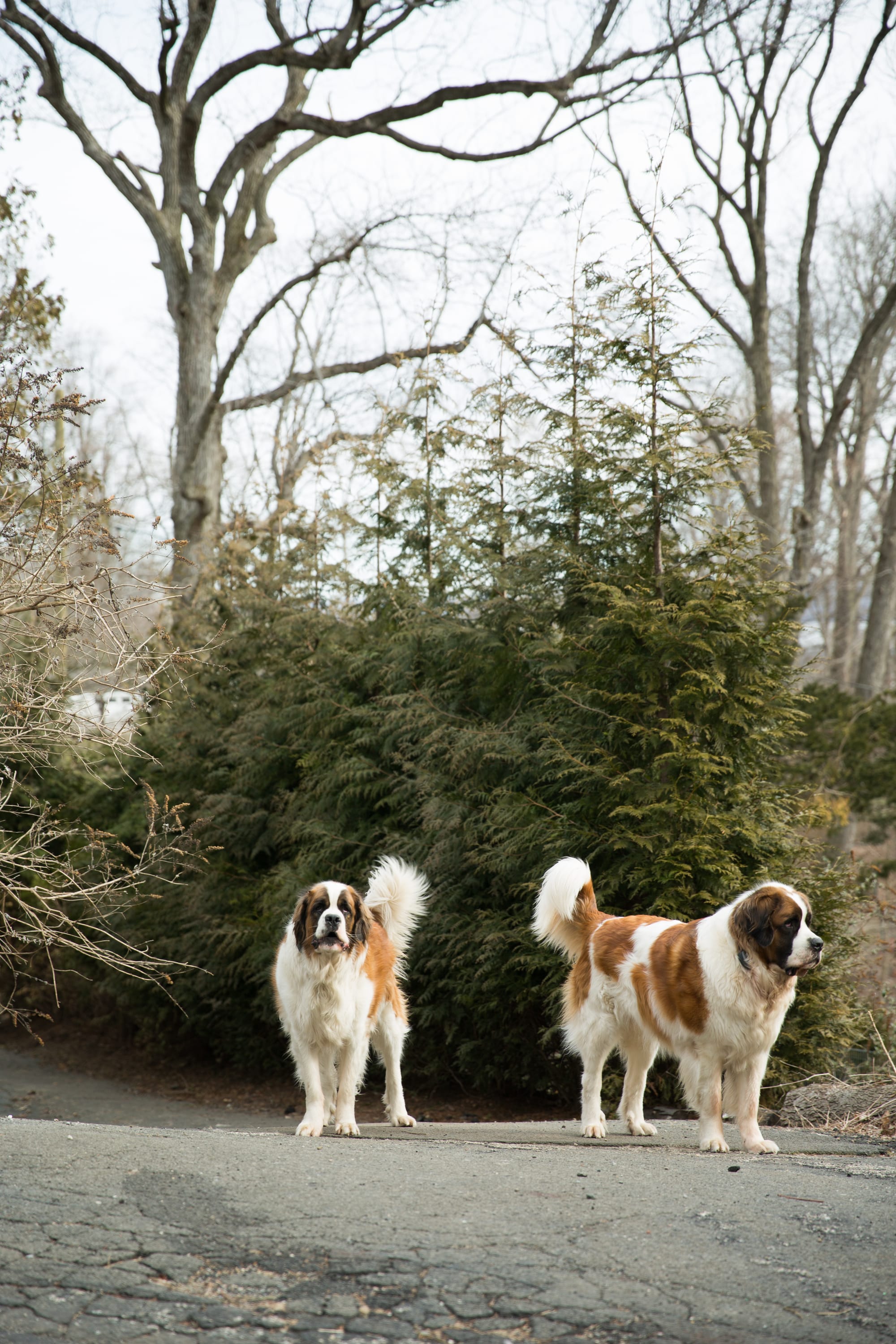Embark on an exploration into the world of St. Bernard dogs, a breed that stands as a testament to loyalty, courage, and unparalleled gentleness. Known for their imposing stature and benevolent demeanor, St. Bernards have captured hearts and imaginations across the globe, not only as majestic companions but also as legendary rescuers. This guide invites both the curious and the prospective owner to delve into the rich tapestry of the St. Bernard's origins, tracing their journey from the snowy passes of the Swiss Alps to the warm hearths of family homes.

As we unravel the history and characteristics that define these gentle giants, new owners will gain invaluable insights into what it means to welcome a St. Bernard into their lives. From understanding their unique needs to appreciating the deep bond they forge with their human families, this guide aims to prepare you for the rewarding journey of St. Bernard ownership, highlighting the joys and responsibilities that come with being a steward of such a noble breed.
The Origins of St. Bernard Dogs
The lineage of St. Bernard dogs is steeped in history, dating back over a thousand years to the remote snow-clad passes of the Swiss Alps. It was here, at the Great St. Bernard Hospice, founded by St. Bernard of Menthon in the 11th century, that the breed found its noble calling. The monks of this hospice, situated at a perilous altitude of nearly 8,000 feet, initially bred these dogs to serve as companions and guardians against intruders. However, the St. Bernards' role soon transcended mere companionship.
As the hospice became a refuge for travelers braving the treacherous pass between Switzerland and Italy, the monks discovered the dogs' extraordinary ability to navigate through blizzards and sense impending avalanches. St. Bernards became renowned for their heroic rescues of lost or stranded travelers, saving countless lives with their strength, endurance, and unerring instinct. The most famous of these rescue dogs was Barry, who is said to have saved over 40 lives in the early 1800s.
Over time, as modern transportation made mountain rescues less common, St. Bernards transitioned from working dogs to beloved family pets. Their calm demeanor, intelligence, and loyalty made them ideal companions. The breed's evolution from monastery guardians to family members did not diminish their heroic stature but rather enriched their legacy. Today, St. Bernards are cherished not just for their historical significance but for their gentle nature, becoming a symbol of kindness and resilience that continues to endear them to people around the world.
Physical Characteristics and Temperament
St. Bernard dogs are a magnificent blend of power and grace, their physical characteristics a testament to the breed's storied past as Alpine rescuers. Towering at 26 to 30 inches at the shoulder and weighing between 120 to 180 pounds, their imposing stature is matched by a dense, muscled frame, built for endurance and strength. Their coats, which come in long and short-haired varieties, offer protection against harsh climates, featuring a predominance of white with markings in red, brown, or brindle. The expressive eyes of a St. Bernard, often described as 'friendly and intelligent,' are set in a massive head with a furrowed brow and a short muzzle, giving them a look of dignified kindness.
Despite their formidable size, St. Bernards possess a temperament that endears them to all. They are known for their gentle nature, displaying an unparalleled level of patience and benevolence. This breed thrives on companionship, showing an innate sense of empathy towards their human families. St. Bernards are particularly affectionate with children, often displaying a protective instinct that is more nurturing than aggressive. Their calm and friendly demeanor, coupled with an eagerness to please, makes them excellent family pets. However, their size and strength necessitate early socialization and training to ensure they remain manageable and well-adjusted companions.
The St. Bernard's temperament is a harmonious blend of loyalty, kindness, and a gentle spirit, making them not just impressive in appearance but also in character. Their capacity for love and devotion, despite their commanding presence, stands as a living testament to the breed's enduring legacy as gentle giants of the canine world.
St. Bernards in Rescue and Legend
The legacy of St. Bernards is indelibly marked by their heroic deeds in rescue missions, a narrative that has elevated them to legendary status both in history and popular culture. Among the annals of their valor, the tales of Barry stand out, epitomizing the breed's bravery and instinct for rescue. Barry, who served at the Great St. Bernard Hospice in the early 1800s, is credited with saving over 40 lives. His most famous rescue, the recovery of a young boy found asleep in a cavern of ice, has been immortalized in countless stories, illustrating the extraordinary bond between St. Bernards and those they save.
These heroic exploits have not only cemented the St. Bernard's reputation as an adept rescuer but have also significantly influenced their depiction in popular culture. The image of a St. Bernard with a brandy barrel around its neck, a myth popularized by artistic renditions, although not historically accurate, has become a symbol of hope and salvation in treacherous conditions. This portrayal has been embraced in literature, film, and art, further entwining the breed with themes of rescue and compassion.
In films and television, St. Bernards are often depicted as gentle giants with a keen sense of loyalty and protection. The Beethoven movie series, for example, showcases a St. Bernard's adventures with a suburban family, highlighting the breed's endearing qualities and capacity for mischief. Similarly, in children's literature and animated series, St. Bernards are portrayed as affable and brave characters, reinforcing their heroic and nurturing nature.
The legends of St. Bernards' rescue missions have not only shaped their image in popular culture but have also fostered a deep appreciation for the breed's unique blend of strength, courage, and kindness. These stories continue to inspire admiration for St. Bernards, celebrating their historical legacy and the timeless virtues they embody.

Bringing a St. Bernard Home: Considerations for First-Time Owners
Bringing a St. Bernard home is a decision that comes with specific considerations, given their notable size and distinctive needs. First-time owners must prepare to accommodate not just a pet, but a gentle giant with a heart to match.
Space and Environment:
St. Bernards thrive in environments where they have ample space to move and relax. Despite their calm indoor demeanor, their large size means they're best suited to homes with spacious living areas and securely fenced yards. While they can adapt to various living situations, including apartments, the key is regular access to outdoor space for exercise and play. Prospective owners should also ensure their living space is safe and free from hazards that might pose risks to such a large dog.
Dietary Needs:
The dietary needs of St. Bernards are as substantial as their size. A balanced diet rich in nutrients is essential to support their bone health, particularly given their susceptibility to joint issues. High-quality commercial dog food formulated for large breeds, portioned according to their age, weight, and activity level, is crucial. Given their risk for bloat, it's advisable to feed them smaller, more frequent meals and avoid exercise immediately before and after eating.
Exercise Requirements:
Despite their imposing presence, St. Bernards do not require excessive exercise. Daily walks and playtime are sufficient to keep them healthy and content. It's important to monitor their activity, especially in puppies, to avoid strain on their developing joints. St. Bernards enjoy leisurely walks and moderate play but are equally content with quiet companionship at home.
For first-time St. Bernard owners, understanding and accommodating these considerations are key to providing a nurturing environment. A commitment to their well-being will ensure that this majestic breed becomes a loving and integral part of the family.

Training and Socialization
Training and socialization are crucial components in the development of a St. Bernard, shaping them into well-adjusted and sociable companions. Their sheer size and strength make early and consistent training not just beneficial but essential.
Early and Consistent Training:
Initiating training during puppyhood leverages a St. Bernard's natural eagerness to please and their capacity for learning. Basic obedience training, including commands such as "sit," "stay," "come," and "down," lays the foundation for a well-behaved dog. Consistency in commands, rewards, and discipline helps the dog understand expectations and reinforces positive behavior. Given their size, leash training is particularly important to ensure they are manageable during walks.
Socialization Tips:
Socialization should start early, exposing your St. Bernard to a variety of people, environments, animals, and situations. This exposure helps them become adaptable and reduces fear and anxiety in new settings.
- Introduce to Various People: Regularly introduce your St. Bernard to different types of people, including children, the elderly, and people in uniforms, to help them become comfortable around diverse groups.
- Meet Other Pets: Allow your St. Bernard to interact with other friendly pets in controlled settings. Dog parks, pet-friendly events, and playdates can be good opportunities for social interaction.
- Positive Experiences: Ensure that socialization experiences are positive. Use treats and praise to associate new encounters with positive outcomes.
- Gradual Exposure: Gradually expose your St. Bernard to various environments, such as busy streets, parks, and pet stores, to accustom them to different stimuli.
- Training Classes: Consider enrolling in puppy training classes, which offer the dual benefit of basic training and socialization with other dogs and people.
Training and socializing a St. Bernard requires patience and understanding, recognizing their gentle nature and tailoring approaches to encourage their best traits. With consistent effort, St. Bernards grow into amiable, well-mannered dogs that are a joy to have as part of any family.

Health and Wellness
Health and wellness are paramount in ensuring a long, fulfilling life for St. Bernard dogs, given their predisposition to certain breed-specific health issues. Awareness and proactive management of these concerns can significantly enhance their quality of life.
Common Health Concerns:
St. Bernards are prone to several health issues, largely due to their size. Hip and elbow dysplasia are common, resulting from the malformation of the respective joints, which can lead to pain and mobility issues. Bloat, or gastric torsion, is another serious condition that affects large breeds, characterized by the rapid swelling of the stomach. Additionally, St. Bernards can be susceptible to heart conditions, such as dilated cardiomyopathy, and eye issues like entropion and ectropion.
Preventative Care:
Preventative care plays a critical role in mitigating the risks of these health issues. Regular veterinary check-ups, at least once a year, are crucial for early detection and management of potential health problems. A balanced diet, formulated for large breeds and tailored to the dog's age, weight, and activity level, supports overall health and joint integrity. Maintaining an appropriate weight is essential to avoid putting extra strain on their joints and heart.
Exercise is important but should be moderated to avoid excessive stress on their developing skeletal structure, particularly in puppies and young dogs. Owners should also be educated about the signs of bloat and seek immediate veterinary attention if symptoms are observed, as it can be life-threatening if not treated promptly.
Regular Veterinary Check-ups:
Routine veterinary visits should include vaccinations, parasite control, and dental care, alongside specific screenings for the health issues prevalent in St. Bernards. Discussions with the vet about the optimal schedule for these check-ups and any additional preventive measures are beneficial.
By prioritizing health and wellness through preventative care and regular veterinary oversight, owners can help ensure their St. Bernard enjoys a healthy, active life. This commitment to their well-being is a cornerstone of responsible pet ownership, fostering a bond that enriches both the dog's life and that of their human companions.

The Joy and Responsibility of Owning a St. Bernard
Owning a St. Bernard brings immense joy and a unique set of responsibilities, marking a journey filled with loyalty, companionship, and unparalleled affection. The rewards of having a St. Bernard by your side are manifold, extending beyond their majestic presence to the deep, unwavering bond they share with their families. Known for their kind-hearted nature, St. Bernards offer a comforting presence, their mere size and gentle demeanor providing a sense of security and companionship that is hard to replicate. Their loyalty is legendary, with a natural propensity to protect and cherish their human counterparts, making them not just pets, but integral members of the family.
Yet, the decision to welcome a St. Bernard into your home is one that demands consideration of the long-term commitments and responsibilities that accompany large breed ownership. Their significant size necessitates appropriate living space, while their health and well-being require regular veterinary care, including monitoring for breed-specific conditions such as hip dysplasia and bloat. The financial implications of feeding, grooming, and healthcare also merit attention, underscoring the need for prospective owners to assess their readiness to meet these demands.
Moreover, St. Bernards thrive on human interaction and can experience separation anxiety if left alone for extended periods. Ensuring that your lifestyle can accommodate the needs of a St. Bernard is crucial, with ample time dedicated to their training, exercise, and socialization to foster a well-adjusted and happy companion.
Embracing the ownership of a St. Bernard is to accept a role filled with love, laughter, and the occasional challenge. It is a journey of mutual growth and understanding, offering unparalleled rewards to those prepared for the responsibilities of caring for these gentle giants.
Conclusion
In traversing the journey of St. Bernard ownership, we've delved into the rich tapestry of their origins, from the snowy Swiss Alps to their cherished role in homes worldwide. We've uncovered the physical and temperamental traits that endear these gentle giants to many, from their impressive stature to their inherent kindness. Tales of legendary rescues have highlighted their bravery, reinforcing their image as compassionate guardians in both history and popular culture.
For first-time owners, we've navigated the considerations of space, diet, and exercise, underscoring the importance of a nurturing environment tailored to a St. Bernard's unique needs. The pivotal roles of training and socialization in fostering a well-mannered companion have been explored, alongside a guide to ensuring their health and wellness through preventative care.
Owning a St. Bernard is a journey filled with joy and companionship, marked by the deep loyalty and affection these dogs lavish upon their families. Yet, it's also a commitment, demanding a readiness to meet the comprehensive needs of such a large breed. The rewards of St. Bernard ownership are profound, offering a bond that is as enriching as it is enduring.
In conclusion, St. Bernards stand as a testament to the power of gentle strength, embodying the essence of the gentle giant. For those ready to embrace the responsibilities, a St. Bernard enriches a household with love, loyalty, and a touch of heroism, making them not just pets, but cherished family members.

FAQs
- What is the history of St. Bernard dogs?
- St. Bernards originated from the Swiss Alps, where they were used by monks at the Great St. Bernard Hospice for rescue missions.
- How big do St. Bernards get?
- Adult St. Bernards typically weigh between 120 to 180 pounds and stand 26 to 30 inches tall at the shoulder.
- Are St. Bernards good family pets?
- Yes, St. Bernards are known for their gentle and friendly nature, making them excellent companions for families.
- What are the exercise needs of a St. Bernard?
- St. Bernards require moderate exercise like daily walks and playtime to stay healthy, but they are not high-energy dogs.
- What kind of diet is best for a St. Bernard?
- A balanced diet formulated for large breeds is ideal, with attention to portion sizes to prevent obesity and bloat.
- How do I train and socialize a St. Bernard?
- Early, consistent training and socialization are crucial. Use positive reinforcement techniques and expose them to various people, pets, and environments.
- What health issues should I be aware of with a St. Bernard?
- Common concerns include hip dysplasia, elbow dysplasia, and bloat. Regular veterinary check-ups can help manage these risks.
- Is it expensive to own a St. Bernard?
- Yes, due to their size, St. Bernards can be more expensive to care for, including food, health care, and space requirements.
- Can St. Bernards live in hot climates?
- St. Bernards can adapt to various climates, but due to their thick coat, they may require extra care in hot weather to prevent overheating.
- What makes St. Bernards unique compared to other breeds?
- Their remarkable history as rescue dogs, combined with their gentle nature and loyalty, sets them apart as both heroic figures and beloved companions.




